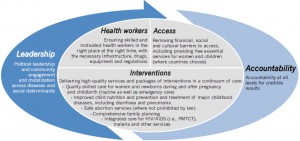Global Strategy for Women’s and Children’s health: the importance of integrated interventions
Posted by markdlevy@gmail.com on Dec 17, 2012 in Research | 0 commentsThe WHO released their Global Strategy for Women’s and Children’s health in 2010. One of the main components of this strategy is ensuring that partners who work on improving maternal and child health implement comprehensive, integrated packages of services.
Working together to accelerate progress
Key elements of the Global Strategy
We know what works. Women and children need an integrated package of essential interventions and services delivered by functioning health systems. Already, many countries are making progress. In Tanzania, for instance, deaths of children under five have fallen by 15-20% because of widespread use of interventions such as immunizations, vitamin A supplements and integrated management of childhood illness. Sri Lanka has reduced maternal mortality by 87% in the past 40 years by ensuring that 99% of pregnant women receive four antenatal visits and give birth in a health facility.
We know what we need to do. In line with the principles of the Paris Declaration, the Accra Agenda for Action and the Monterrey Consensus, all partners must work closely together in the following areas:
Country-led health plans. Partners must support existing, costed national health plans to improve access to services. Such plans cover human resources, financing, and delivery and monitoring of an integrated package of interventions.
A comprehensive, integrated package of essential interventions and services. Partners must ensure that women and children have access to a universal package of guaranteed benefits, including family-planning information and services, antenatal, newborn and postnatal care, emergency obstetric and newborn care, skilled care during childbirth at appropriate facilities, safe abortion services (when abortion is not prohibited by law), and the prevention of HIV and other sexually transmitted infections. Interventions should also include: exclusive breastfeeding for infants up to six months; vaccines and immunization; oral rehydration therapy and zinc supplements to manage diarrhea; treatment for the major childhood illnesses; nutritional supplements (such as vitamin A); and access to appropriate ready-to-eat foods to prevent and treat malnutrition.
Integrated care improves health promotion and helps prevent and treat diseases such as pneumonia, diarrhea, HIV/AIDS, malaria, tuberculosis, and non-communicable diseases. Stronger links must be built between disease-specific programs (such as for HIV/AIDS, malaria and tuberculosis) and services targeting women and children (such as the Expanded Programme on Immunization, sexual and reproductive health and the Integrated Management of Childhood Illness). Partners should coordinate efforts with those working in other sectors to address issues that impact on health, such as sanitation, safe drinking water, malnutrition, gender equality and women’s empowerment.
Health systems strengthening. Partners must support efforts to strengthen health systems to deliver integrated, high-quality services. They should extend the reach of existing services, especially at the community level and to the underserved, and manage scarce resources more effectively. They also need to build more health facilities to give vulnerable people access to medical expertise and drugs.
Health workforce capacity building. Partners must work together to address critical shortages of health workers at all levels. They must provide coordinated and coherent support to help countries develop and implement national health plans that include strategies to train, retain and deploy health workers.
Coordinated research and innovation. Partners must find innovative ways to provide high-quality care and to expand research programs that develop new interventions, such as vaccines, medicines and diagnostic devices. They must develop, fund and implement a prioritized and coordinated global research agenda for women’s and children’s health, and strengthen research institutions and systems in low- and middle-income countries.
The “Global Consensus for Maternal, Newborn and Child Health” (see Figure 1), developed and adopted by a wide range of stakeholders, lays out an approach to speed up progress. It highlights the need to align policies, investment and delivery around a cohesive set of priority interventions across what health professionals call the continuum of care, and offers a framework for stakeholders to take coordinated action.
Figure 1. The global consensus for Maternal, newborn and child health
https://nutrientsforall.appchamps.com//www.who.int/pmnch/topics/maternal/201009_globalstrategy_wch/en/index3.html

